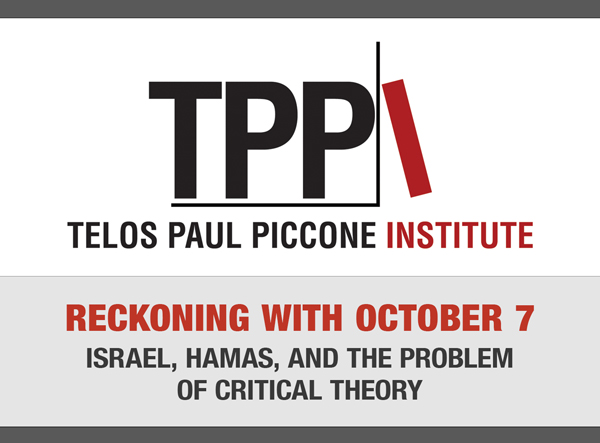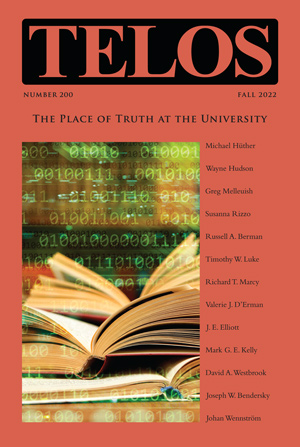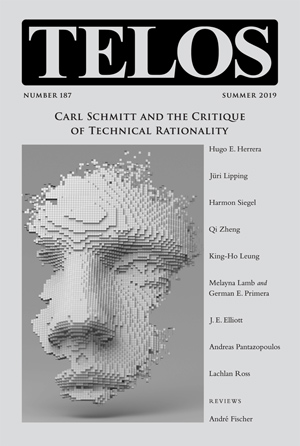By Peter C. Herman · Friday, May 17, 2024 The following essay is part of a special series of responses to recent events centered, for now, at Columbia University, and extending beyond its confines to include the wider array of societal problems that the disorder there symptomatizes. For details, see Gabriel Noah Brahm, “From Palestine Avenue to Morningside Heights.”—Gabriel Noah Brahm, Director of the Telos-Paul Piccone Institute’s Israel initiative  In 1959, C. P. Snow delivered the Rede Lecture on “The Two Cultures.” Snow’s fundamental point was that humanists and scientists speak past each other, assuming that they communicate at all. “[I]ntellectual life,” Snow writes, “is increasingly being split into two polar groups.” At one end, “literary intellectuals,” at the other, “scientists,” and between the two “a gulf of mutual incomprehension—sometimes (particularly among the young) hostility and dislike, but most of all lack of understanding.” Scientists don’t read any imaginative literature because it has no practical application; and humanists ignore science because they think it is “of no interest either in its own value or its consequences.” The result is a split that does nobody any good. In 1959, C. P. Snow delivered the Rede Lecture on “The Two Cultures.” Snow’s fundamental point was that humanists and scientists speak past each other, assuming that they communicate at all. “[I]ntellectual life,” Snow writes, “is increasingly being split into two polar groups.” At one end, “literary intellectuals,” at the other, “scientists,” and between the two “a gulf of mutual incomprehension—sometimes (particularly among the young) hostility and dislike, but most of all lack of understanding.” Scientists don’t read any imaginative literature because it has no practical application; and humanists ignore science because they think it is “of no interest either in its own value or its consequences.” The result is a split that does nobody any good.
While Snow’s thesis has not entirely aged well (many universities today, for example, mandate that students take courses in both the sciences and the humanities) and while one can find isolated examples of people combining both (e.g., Oliver Sacks), the response by faculty to the recent wave of protests shows that a deep gulf still separates the humanities and the sciences.
Continue reading →
By Russell A. Berman · Thursday, May 9, 2024 The following essay is part of a special series of responses to recent events centered, for now, at Columbia University, and extending beyond its confines to include the wider array of societal problems that the disorder there symptomatizes. For details, see Gabriel Noah Brahm, “From Palestine Avenue to Morningside Heights.”—Gabriel Noah Brahm, Director of the Telos-Paul Piccone Institute’s Israel initiative  In the immediate aftermath of the attacks of October 7, and now again during the spring, coordinated protests have spread through colleges and universities. The rapidity with which normal functioning was disrupted and the initial helplessness of administrators both point to fundamental weaknesses in higher education: I doubt that there can be a return to a pre-October 7 normalcy. Public dismay with universities was already pronounced before these events, and the campus chaos has triggered memories of the lawlessness of the George Floyd riots. In the immediate aftermath of the attacks of October 7, and now again during the spring, coordinated protests have spread through colleges and universities. The rapidity with which normal functioning was disrupted and the initial helplessness of administrators both point to fundamental weaknesses in higher education: I doubt that there can be a return to a pre-October 7 normalcy. Public dismay with universities was already pronounced before these events, and the campus chaos has triggered memories of the lawlessness of the George Floyd riots.
There are certainly deep and substantive problems inside academia that explain these events—and I will turn to them in a moment—but it is important first to take stock of what really transpired and not surrender to sensationalist overstatements. It is true that demonstrations have taken place at many colleges, but the number of participants at each has been limited when measured against total enrollment. There were 119 arrests at Columbia, where the student body totals some 36,000. It is also true that antisemitic discourse has emerged, but the extent of its spread is unclear. At Stanford a student vote calling for divestment won 75% support—which is disheartening—but only about 25% of eligible voters took part, so the result only documents an anti-Israel sentiment of 18% of the student body. We need more data.
From the arrest records, we learn that many of the protestors were not students or faculty but came from outside activist organizations. At Columbia, 32 of the 119 were outsiders; at CCNY, 102 of the 173 were not from the university. There is enough evidence to point to a coordinated plan by groups to promote disruption, to commit crimes and especially to radicalize the discourse. For example, a well-meaning student attracted to the logic of a two-state solution—hardly an extremist position—might well show up at an encampment but then be pushed into supporting Hamas or the elimination of Israel, indisputably extreme stances. That radicalization has gone unquestioned. There are no signs of internal debate between, say, supporters of Palestinian national self-determination on the one hand and, on the other, proponents of “global intifada” and “smashing” capitalism. Those are two very different programs, but radical leadership has managed to establish the latter as the norm in the protest camps. It has also left previously unorganized students facing the consequences of arrest and the career damage of a criminal conviction.
Continue reading →
By João Pedro Cachopo · Monday, March 27, 2023 It happened on May 11, 1997. After a defeat, a victory, and three draws, Deep Blue, programmed by IBM, would eventually win the sixth and decisive game of the historic chess match against Garry Kasparov. The Russian chess player, incredulous and upset, did not take the defeat well. In fact, given the machine’s behavior during the game, he protested: some of its moves seemed to indicate human intervention.
Today, more than twenty-five years later, the most amazing thing is that Kasparov thought it possible to continue to beat a computer that was already capable of analyzing one hundred million moves per second at that time. Nevertheless, it is ironic that his defeat was later speculated to be due to the fact that Kasparov had interpreted a move resulting from a software bug as strategic. According to Nate Silver, who tells the anecdote in The Signal and the Noise, it was that move, enigmatic in its aims, that fatally distracted the chess player.
The controversy surrounding Artificial Intelligence is back. However, it is no longer just due to its ability to calculate that the machine, in the era of “big data” and “deep learning,” threatens to surpass human intelligence. Take the case of OpenAI. With Dall-E and ChatGPT, the uses of Artificial Intelligence invade the domains of creation and knowledge. In the former case, a program capable of creating images in the style of this or that artist, enlarging their masterpieces, and crossbreeding their styles. In the latter case, a program capable of producing text by gathering, synthesizing, and cross-referencing information in informal conversations with the user. Disbelief and unease are spreading. Human pride is wounded. Was Kasparov’s defeat not enough? Do they now want to dethrone Vermeer, Beethoven, Kant?
Continue reading →
By David Pan · Thursday, December 15, 2022  As the teaching assistant strike at the University of California extends into its fifth week, it seems that education has increasingly merged with activism. In fact, J. E. Elliott argues in our podcast interview that the development of the humanities in particular has moved so far in this direction that activism has become the explicit focus and attraction of majoring in the humanities for college students. As he lays out, such activist-oriented education is not a form of resistance but a result of the corporatization of the university, which involves not just links between corporations and universities but also the way in which college education has developed into a mass market commodity. The expansion of higher education, in promoting the admission of larger proportions of the population into college, has diluted the elite character of the college degree, making it into a more purely professional qualification and forcing colleges to devote more effort into justifying the value of their degrees for the job market. Because the ideals of inclusion and of merit are inherently contradictory, integrating more students into college has devalued the degree credential and therefore colleges must design their programs with an eye toward different segments of the higher education market. Consequently, the humanities at U.S. universities have evolved to establish “Brand English” to compete with “Brand STEM” and “Brand Business” by promoting social activism as its main distinguishing characteristic. As the teaching assistant strike at the University of California extends into its fifth week, it seems that education has increasingly merged with activism. In fact, J. E. Elliott argues in our podcast interview that the development of the humanities in particular has moved so far in this direction that activism has become the explicit focus and attraction of majoring in the humanities for college students. As he lays out, such activist-oriented education is not a form of resistance but a result of the corporatization of the university, which involves not just links between corporations and universities but also the way in which college education has developed into a mass market commodity. The expansion of higher education, in promoting the admission of larger proportions of the population into college, has diluted the elite character of the college degree, making it into a more purely professional qualification and forcing colleges to devote more effort into justifying the value of their degrees for the job market. Because the ideals of inclusion and of merit are inherently contradictory, integrating more students into college has devalued the degree credential and therefore colleges must design their programs with an eye toward different segments of the higher education market. Consequently, the humanities at U.S. universities have evolved to establish “Brand English” to compete with “Brand STEM” and “Brand Business” by promoting social activism as its main distinguishing characteristic.
Without the traditional literary and intellectual canons, the focus of humanities education has shifted toward promoting diversity, equity, and inclusion, which have become in many respects code words for identity politics, socialist-inspired redistribution, and college for all as entry into the job market. But because these three policies are partisan positions that have been enshrined as overarching truths (or in Elliott’s terms, “truth-posits”) for higher education, college humanities have to a large extent abandoned genuine debate about the origins and consequences of different ideas in favor of activist promotion of such ideas. The strike itself foregrounds the focus on equity without, however, considering the consequences of such a policy.
Continue reading →
By J. E. Elliott · Thursday, August 1, 2019 J. E. Elliott’s “Insourcing Dissent: Brand English in the Entrepreneurial University” appears in Telos 187 (Summer 2019). Read the full article at the Telos Online website, or purchase a print copy of the issue in our online store. Individual subscriptions to Telos are available in both print and online formats.
 This essay addresses the emergence of dissent culture as a hallmark of teaching and research in English studies and the humanities more generally in the time and temper of the commercial-bureaucratic university. I argue that the most convincing explanation for the widespread adoption of a protest ethos in an institution ostensibly opposed to its prescriptions is not a paradigm shift from formalist to political approaches to texts and artifacts, much less principled opposition to late Western capitalism or technological reason, but a reproduction of the routines, scripts, norms, and values of American higher education as an entrepreneurial enterprise. Dissent, in other words, is an organizationally conservative force: it animates disciplinary alternatives to STEM and business curricula while articulating a remedial narrative of inclusiveness (“diversity”) that bears witness to American higher education’s residual commitments to political engagement and democracy building. This insourcing of protest has assured English studies’ viability in the corporate university by reconfiguring the discipline as an academic brand alongside Brand Science and Brand Business in the organizational field of the university. To the extent that the politics of advocating for the disempowered and marginalized is an in-house creation without demonstrable political or policy-related impact, however, dissent culture can also be read as a reflexive (and symptomatic) protest against its own institutional capture. The essay concludes with a discussion of prospective alterations to Brand English in light of recent developments in the digital humanities. This essay addresses the emergence of dissent culture as a hallmark of teaching and research in English studies and the humanities more generally in the time and temper of the commercial-bureaucratic university. I argue that the most convincing explanation for the widespread adoption of a protest ethos in an institution ostensibly opposed to its prescriptions is not a paradigm shift from formalist to political approaches to texts and artifacts, much less principled opposition to late Western capitalism or technological reason, but a reproduction of the routines, scripts, norms, and values of American higher education as an entrepreneurial enterprise. Dissent, in other words, is an organizationally conservative force: it animates disciplinary alternatives to STEM and business curricula while articulating a remedial narrative of inclusiveness (“diversity”) that bears witness to American higher education’s residual commitments to political engagement and democracy building. This insourcing of protest has assured English studies’ viability in the corporate university by reconfiguring the discipline as an academic brand alongside Brand Science and Brand Business in the organizational field of the university. To the extent that the politics of advocating for the disempowered and marginalized is an in-house creation without demonstrable political or policy-related impact, however, dissent culture can also be read as a reflexive (and symptomatic) protest against its own institutional capture. The essay concludes with a discussion of prospective alterations to Brand English in light of recent developments in the digital humanities.
Continue reading →
By Peter C. Herman · Friday, May 11, 2018 In the April 12, 2018, issue of Art Journal, the editor, Rebecca Brown, introduces a work of art (really, a computer program), called CitationBomb by Zach Kailer, intended to create a kind of “denial of service” attack on Google Scholar: “The more users do this, the more Google Scholar will become overflowed with citations. This will make it difficult for the algorithms to make sense of influence or impact.” The overall point is to “devalue scholarly metrics” as they represent in small the horrors of the neoliberal university. As Brown puts it, “what numerical value applies to achieving the arc of a compelling paragraph? [It makes] manifest the un-usefulness of analytics . . . its profound, destructive force.”
Why are “analytics” so destructive? Kaiser explains that Google Scholar incentives “clickbait scholarship.” Meaning, since Google Scholar puts first the books or articles that get the most citations, this leads to a “winner take all” situation with scholarship. Only the articles that are cited often get cited at all, leaving all the other scholars in the dust.
Continue reading →
|
|
 In 1959, C. P. Snow delivered the Rede Lecture on “The Two Cultures.” Snow’s fundamental point was that humanists and scientists speak past each other, assuming that they communicate at all. “[I]ntellectual life,” Snow writes, “is increasingly being split into two polar groups.” At one end, “literary intellectuals,” at the other, “scientists,” and between the two “a gulf of mutual incomprehension—sometimes (particularly among the young) hostility and dislike, but most of all lack of understanding.” Scientists don’t read any imaginative literature because it has no practical application; and humanists ignore science because they think it is “of no interest either in its own value or its consequences.” The result is a split that does nobody any good.
In 1959, C. P. Snow delivered the Rede Lecture on “The Two Cultures.” Snow’s fundamental point was that humanists and scientists speak past each other, assuming that they communicate at all. “[I]ntellectual life,” Snow writes, “is increasingly being split into two polar groups.” At one end, “literary intellectuals,” at the other, “scientists,” and between the two “a gulf of mutual incomprehension—sometimes (particularly among the young) hostility and dislike, but most of all lack of understanding.” Scientists don’t read any imaginative literature because it has no practical application; and humanists ignore science because they think it is “of no interest either in its own value or its consequences.” The result is a split that does nobody any good. 



